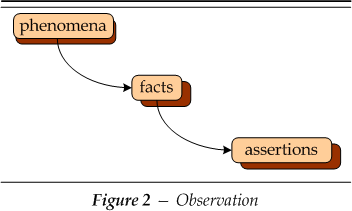
| Observation is involved to some extent in every stage of the scientific method. We consider here the principle modes of thought that are involved in the approach of the scientist at this early stage. But these modes will be revisited regularly by the careful investigator. |

Analysis.As is true for every normal human being, a scientist’s observations are directed toward the various phenomena of the real world. The usual and sometimes too naive assumption is that these phenomena are confined to the three dimensions of space and the one of time. Suppose an observer pays attention to the details of an event by examining and measuring its time and place. Already there are constraints whether conscious or unconscious that lead one to subdivide the event into parts or aspects along multiple other dimensions. There is talk of “onset” or “completion,” “surface” or “interior,” “strength” or “resistance.” Such dividing and isolating of phenomena are what the scientific investigator would call analysis. There seems to be no limit to the number and kinds of parts into which an investigator may analyze, and dimensions along which one may measure a particular phenomenon. |
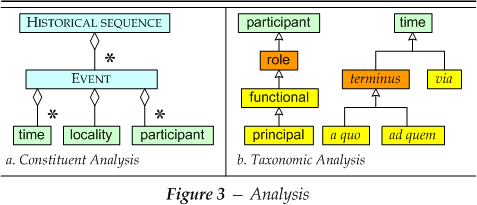
| Figure 3 models the analysis of a series of historical events. A good example from history might be the analysis of a war as composed of several battles. The model shows composition with little rhombus ends on the lines to each of the constituent parts. Each battle took place over a particular time period. In the model the period is a via, Latin for “path” This path is directed in time and these points help to define the event. We may call the class of beginnings the terminus a quo of the entity and the ends the terminus ad quem of the entity. Instead of composition, these labels are concerned with types or classes of the parts of time. The model shows taxonomy by the use of an arrow to connect the label of each class or subclass to the class or part classified. There may be many individual participants involved in an historical event. In order to show the many-to-one relationship the constuency model has a star by the arrow by the part that occurs multiply. With some social events one of its participants is singled out as the “principal.” |
Synthesis.In contrast to analysis there is the situation where the investigator chooses to see a set of phenomena as a single indivisible whole. In this case one holds analytic reasoning in abeyance and instead uses synthesis as the mode of reasoning. This is the kind of reasoning that characterizes holistic approaches. The scientist who has studied living organisms may see them as units in a larger ecological system, and then consider various ecosystems as parts of a “living” planet. As with analytic reasoning there is freedom to create. There seems to be no limit to the kinds of wholes that an investigator may treat a particular phenomenon as part of or as an instance of. Synthesis takes place when we fail to account for structural differences in component parts. Consider, for example, an historical record of a census enumeration. In this case the structure of the document analyzes the family as a group of individual persons living in a household at a particular time. The relevant information from the enumeration is extracted and synthesized into the appropriate parts of the structure of a nuclear family, which must have existed through that time. |
Theory or model.Concomitant with the processes of analysis and synthesis the investigator makes judgments based on some theory or model. In fact, it is impossible to perform either analysis or synthesis without some sort of theory to begin with, be it naive or sophisticated. The theory explains the order that we see as inherent in the real world. These two kinds of reasoning lead one to modify or reformulate one’s conceptualization of this order. It is also a mistake to assume that analysis and synthesis are independent processes. It is impossible to analyze something without also viewing it in some larger context, and this is synthesis. In order to proceed from the known and accepted to the unknown and undreamed of, it is possible to take either direction — toward the more particular or toward the more general. |
Principles.What makes analysis possible? Doesn’t the world already consist in its visible parts. Aren’t there some things that naturally come in instances? Or perhaps as investigators respond to the world, they are simply observing constraints on the operation of the mind. Is the order that exists in the world imposed by some underlying set of principles? Or are principles simply a description of an order that is inherent? Ontological and epistemological questions of this sort have occupied the minds of many great philosophers down through the ages. It would be presumptive on my part to suggest that there should be a definitive answer. We have already indicated that the answer depends heavily on the theoretical environment. Yet it seems clear enough that principles are, in the least, descriptive abstractions — a means of understanding the world. The investigator observes that certain entities are related in certain ways and that they continue in these relationships. For the observer this becomes an essential working principle. |
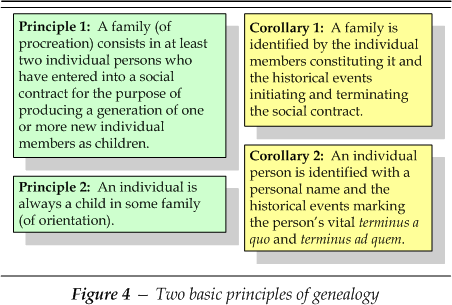
| Figure 4 illustrates two principles that might be useful in the field of genealogy. The first relates to the nuclear family, the second to the individual person — the two most basic objects of genealogical study. The principles define these elements and relate them to their essential context in the world, tellling us how to identify them in simple terms. |
Attributes.One may claim that the physical senses of the human observer and the instruments invented for extending our senses are what impose salience on certain characteristics of our objects of study. In any case such characteristics are connected to or suggest terms in our language by the use of which we may choose to describe the object. According to principles of evolution as developed by Charles Robert Darwin (1809–1882) the necessity to survive has had the result that human beings are naturally endowed with the ability to perceive those attributes that are most significant for their survival. Philosophers have analyzed attributes as of two kinds: inherent and accidental. Those attributes that tell the perceiver that the entity continues to exist are its inherent attributes. Those that change are the accidental attributes. The line between the two is more practical than real. Terms or symbols for the more or less well defined attributes are indispensable tools for the mind. These arise through reason out of our experience with these attributes as distinct. All the objects of our observation come to display attributes significant for their existence or at least significant for their definition. |
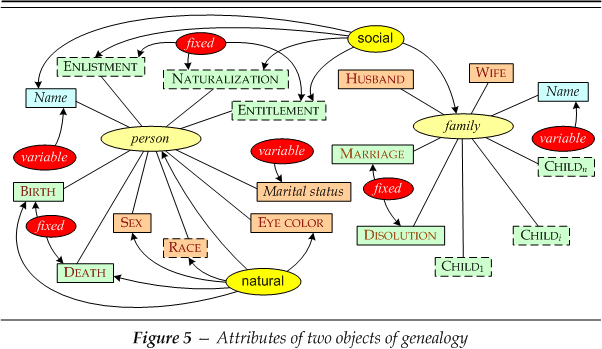
| Figure 5 diagrams the two objects important in genealogy — an individual person and a family. Some of the attributes that might be defined for these objects are listed. The attributes in brown are those that would be inherent — all objects of their class must have them by definition. Note that in a family the husband and wife are essential, whereas the children are always accidental (philosophically speaking). Note also that attributes are themselves entities in their own right and each has its own taxonomy. We have also pointed out a couple of important classes or features of these objects: natural vs. social; fixed vs. variable. |
Terminology.Different sciences and scientific theories select different objects and attributes to codify. The attributes of the animate world find their codification in the natural sciences; those of the inanimate world, in the physical sciences. The theories of molecular biology stand astride the two, so as to blur the boundary between them. In any case the development of a terminology in science is essential to observation. Imagine how daunting the tasks of documentation and classification would be without a developed vocabulary. The terminology is what Carl von Linnaeus (1707–1778) and subsequent natural scientists seek to develop each time they are confronted with the plethora of flora and fauna peculiar to a locality. Ultimately their investigations become the more productive due to the care initially taken in classifying. The assignment of a systematic terminology during the building of a model creates the taxonomy involved in analysis. Out of the bootstrap efforts of naturalists in building models we continue to witness the growth and blossoming of the theory of evolution. It is the strength of this theory that has in a sense served to legitimate the investigators’ self-assigned task of classifying all living things. |

Classification.A rather dominant approach taken in library science is that of classification. In this study the scientist takes the productions of authors and artists as the phenomena to be observed with an eye to assigning them to different classes. Accordingly the librarian may pay attention to different physical characteristics to decide on the best storage methods. In more recent times family historians have taken to tape recording and transcribing living memories. The content of web pages on the internet is a source having another technically novel set of physical characteristics. Leaving the world of documents the modern genealogist has sometimes brought to bear evidence from the biological analysis of the genetic component of a person’s cells. The genealogist excerpts appropriate records as the documentation for the fact that particular individuals lived. His attention may be on the content of each collection — the time period when and the jurisdiction where it was produced. In classifying the identifications as relevant or not most investigators augment documentation with an appeal to their own intuition — they make their own judgment concerning the individual’s identification and relationships. As in the natural sciences we would assume that any classification scheme, no matter how it has come to be constructed, must eventually be legitimatized by the strength and endurance of the theory that arises from it. |
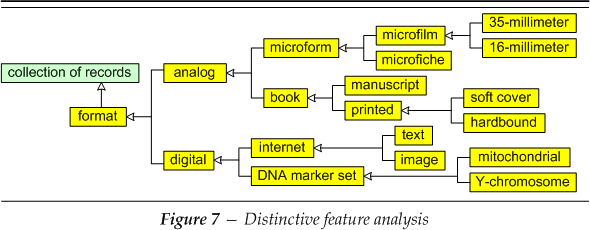
Deduction.Even as terminology is an indispensable tool to observation, so also we cannot omit the definitions and statements that in effect relate the terms to each other. The Greek philosopher Aristotle of Macedonia (384–322BC) held that all facts are either assumed to be true or deduced from them by the use of reason. Scientists since his time have maintained that they ought to regard certain facts as dependent on certain other more basic facts. Some facts are logical consequences of other facts. The French philosopher René Descartes (1596–1650) and many subsequent philosophers — at least down to include the school of logical positivists in the last century — assumed that logical deduction was sufficient to discover all truth. Even though logical deduction is still an important part of their repertoire, most scientists will accept other tools to demonstrate the (probable) truth of their statements. Of course Aristotle did not appreciate the need to build a scientific theory. When he observed a relationship such as that which holds between cause and effect, he considered it mirrored in the mind and manifested in deductive reasoning. Clearly it was possible to deduce the effect provided the observer knew the inherent attributes of the cause. For Aristotle any facts produced by such reasoning were the end of any explanation of objective reality. |
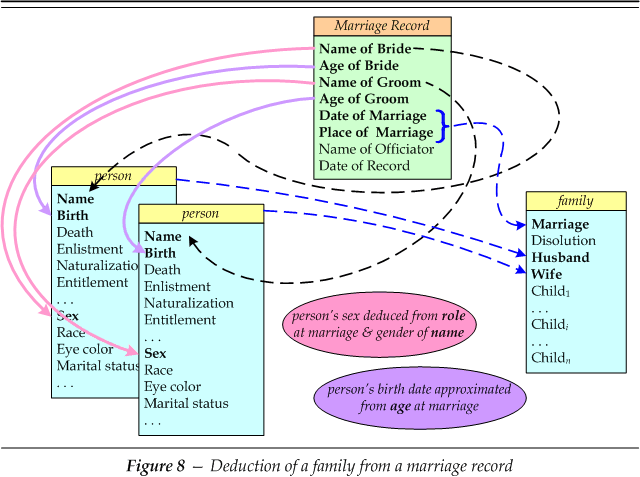
| It is easy to find examples of deduction as applied in the field of genealogy. When the genealogist finds the correct source for information on the family he is trying to establish, he must deduce the identifying attributes he is looking for. Figure 8 illlustrates what happens. There are historical traces of a family in the marriage record. Principle one implies that this record establishes a family consisting of a husband and wife. The bride on the record becomes the wife and the groom becomes the husband. This deduction is based on the definition of each of these elements. The birth events of these individuals can also be deduced; this data comes from their ages as may be given on the marriage record. If the ages are not given, their ages would have to be inferred from their probable ages at such an event in their culture. |
Language of mathematics.Very probably the Greeks were unsuccessful in making the distinction that we routinely make between the words of our language on the one hand and the ideas that our words express on the other. Today it is still easy to forget that in general the structure of language fails to correspond very well with the structure of the world — or more exactly, with the structure of scientific theory. The degree of correspondence is clearly sufficient to ensure man’s survival. Still, our language in everyday use manages at best to express only a naive and superficial understanding of our environment (Lakoff & Johnson, 1980). People who undertake the development of a full scientific theory have abandoned our own natural language in favor of the artificial language of mathematics. It seems that natural language has not kept pace in some areas with the burgeoning of man’s understanding. The process of describing nature has come to require the more fully functional terminology of mathematics. (Yet even here there is reason to believe that many mathematicians loose sight of the fact that mathematics is a language of the same remove from reality as natural languages.) The idea that mathematics is guided by metaphor as much as any natural language is pursued in the recent book Where Mathematics Comes From (2001). |